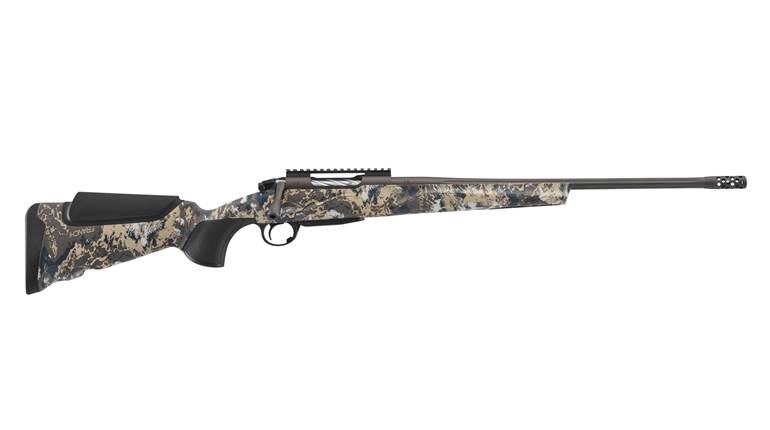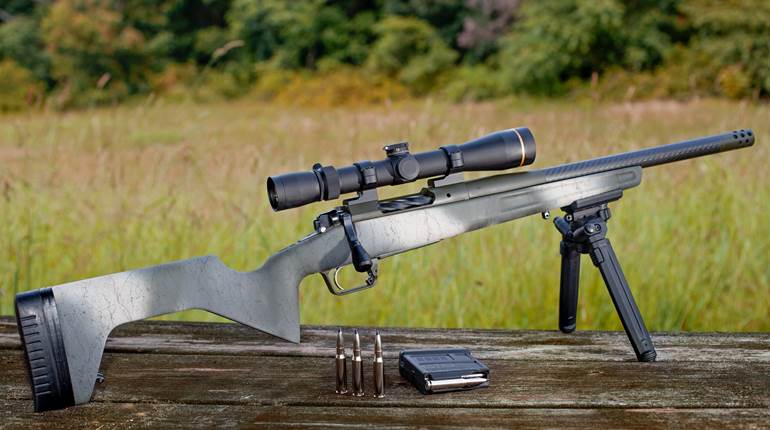
Originally introduced by Mossberg as the Varmint (2011) and Predator (2012) rifles—together, the MVP line—the 5.56x45 mm NATO-chambered, bolt-action duo has given rise to an entire family of long guns, thoughtfully equipped for myriad roles including, but certainly not limited to, their namesake hunting pursuits. Models chambered for 7.62x51 mm NATO (.308 Win.) were introduced in 2013, giving the line access to the renowned big game/utility cartridge, and, with few exceptions, MVP rifle models can be had in either of the NATO chamberings. Given the line’s purpose-driven designs and service-caliber chamberings, not to mention Mossberg’s military and law enforcement heritage, it was probably a safe bet that tactical models would also be cataloged under the MVP banner eventually. One such rifle, the MVP LR Tactical, is the subject of this review.
Exploring the rifle’s nomenclature reveals a very accurate description of the MVP LR Tactical’s characteristics. Just as MVP is shorthand for Mossberg Varmint and Predator, LR rifles are so designated to denote features that facilitate long range shooting—primarily the barrel contour and stock design. The category is further divided to include a Tactical rifle that retains staple features of the MVP line and the LR model, but has been shortened and streamlined to meet the needs, and fit the constraints, of a duty or patrol rifle (not to be confused with the MVP Patrol family of rifles, a separate subset with their own distinctive features).

Our test rifle is the 7.62 mm version of the LR Tactical—a 5.56 mm model is also available. The MVP line originally distinguished itself by offering a bolt-operated action capable of feeding from a standard AR-15-style magazine. The 7.62 mm variants followed suit by accepting and feeding from SR25 and M1A/M14-style magazines. This compatibility is accomplished by pairing an innovative magazine well and latch with Mossberg’s MVP 7.62 mm Dual Push bolt design. The former is a polymer unit that drops into the stock and features a magazine release tab at the front right corner of the well. Pressing the release rearward simultaneously retracts both a forward lug—designed to engage the “hook” port on a M14 magazine—and the left-rear lug that secures SR25-style magazines. The arrangement allows for straight, upward insertion of both types of magazine, even dispensing with the “hook-and-rock” technique associated with the M14.
The MVP 7.62 mm Dual Push bolt is, at first glance, a typical two-lug, push-feed bolt arrangement with a spiral-fluted body and a handle that angles slightly rearward and is capped by a heavy-duty knob—0.88" in diameter with five grip-improving grooves running the circumference. But the bolt’s face is somewhat of a combination of AR-10 and M14 features. It possesses two opposed locking lugs, the right of which houses the sliding-plate-style extractor and features a channel cutout that interfaces with an internal guide rail running the length of the action and forming the bottom edge of the ejection port. Two small cartridge-guide lugs protrude from the bottom of the bolt’s face—reminiscent of an AR bolt face—to feed fresh rounds from staggered-column magazines, regardless of the cartridge’s position. The assembly also uses a plunger-style ejector, located at about the 7-o’clock position when the bolt is out of battery.

Features common to the MVP LR models are a threaded, medium-contour barrel and a stock with an adjustable comb—on the standard rifles the former is 20" long and features straight fluting while the latter is a wood product covered in a green, textured paint and possessing a very pronounced pistol grip. The MVP LR Tactical is shortened and streamlined, with a 16.25" non-fluted barrel and a sportier stock that retains the finish and adjustable comb, but has a more open pistol grip. The barrel is threaded at the muzzle, 5/8x24, and comes with a knurled thread protector.
Optimizing its utility in the field, the rifle’s stock has three studs—two forward, one aft—for attaching a sling and bipod. The comb assembly has two smooth pillars and one central screw that align with corresponding vertical holes in the stock, and retention for the adjustable cheekrest is provided by a spring-tensioned ring inside the center hole, which is grooved to engage the threads of the screw. The comb can be raised, about 1", by depressing a button on the right side of the buttstock and pulling up on the cheekrest. The system looks clean and refined, and we found it was easy to use, but at its maximum height the cheekrest is a bit unstable, rocking slightly fore and aft.

The MVP LR Tactical also distinguishes itself with the addition of Williams adjustable iron sights. The arrangement includes a fully adjustable open rear sight, mounted about 11" back from the muzzle, and a fixed front sight with a red fiber-optic pipe. The configuration is very similar to those found on guide guns or dangerous game rifles. Additionally, and more appropriate for the LR designation, there is 6" of Picatinny rail above the receiver for mounting magnified optics. Finally, the rifle’s controls are pretty straightforward: magazine release and comb adjustment as previously described, a thumb safety at the right rear of the receiver—the forward “fire” position reveals a red indicator—and a bolt release latch at the left rear of the receiver. It’s worth noting that the safety blocks the trigger, but does not prevent manipulation of the bolt.
Evaluators were able to put the MVP LR Tactical through its paces, both in the field and at the range. Topped with an EOTech holographic sight and 5X magnifier, and shooting Nosler .308 Win. loads with 168-gr. E-Tip bullets, the rifle was used to take a nice bull elk near Ennis, Mont. Our hunter praised the rifle, short and stout as it is, for its excellent handling and portability, especially in heavy timber and dense vegetation. At the range, using American Rifleman protocol, the gun performed well, but never with the tack-driving accuracy we had hoped for. Overall, we found the rifle to be capable, handy in the field, and versatile thanks to its combination of precision- and patrol-oriented features.







































